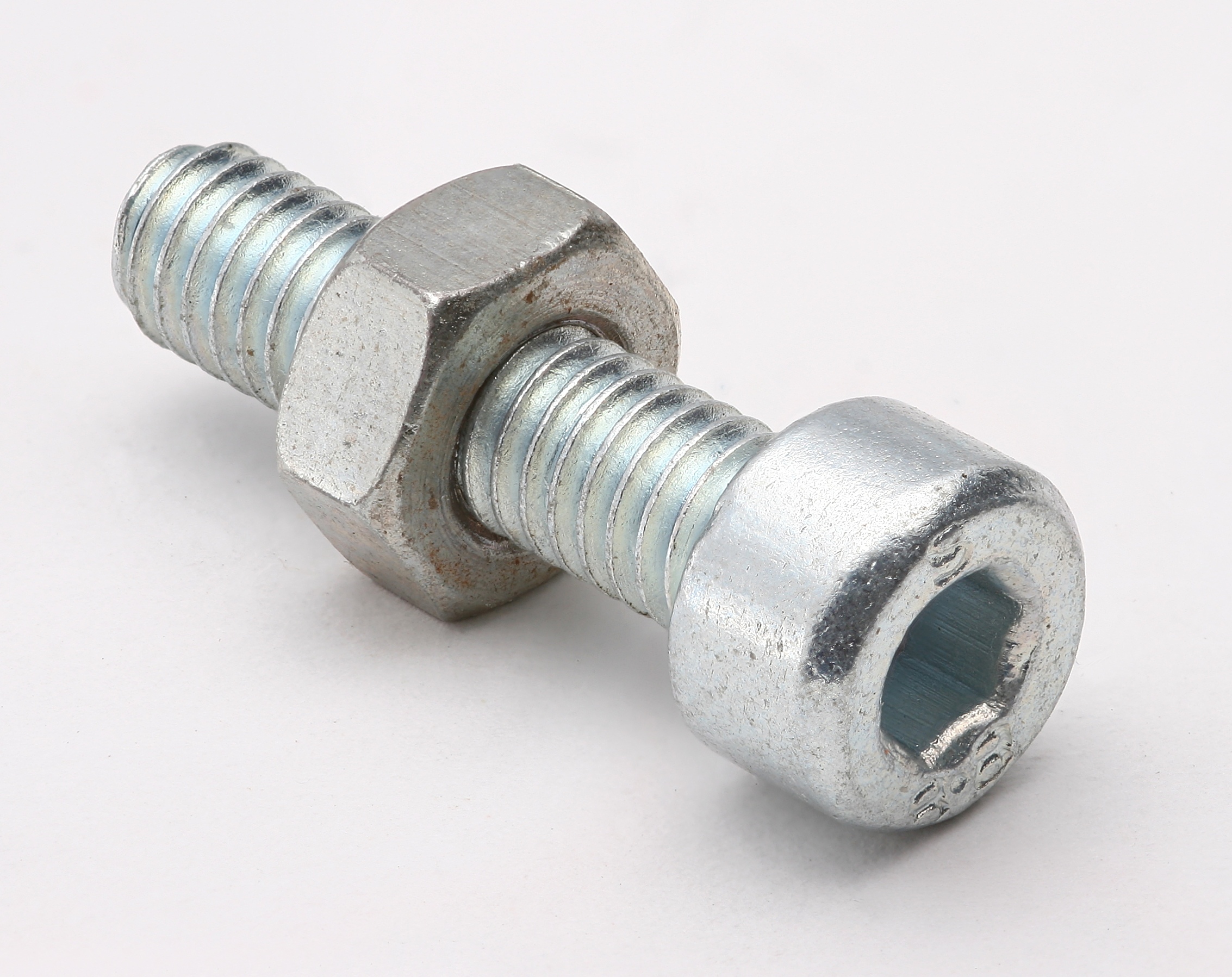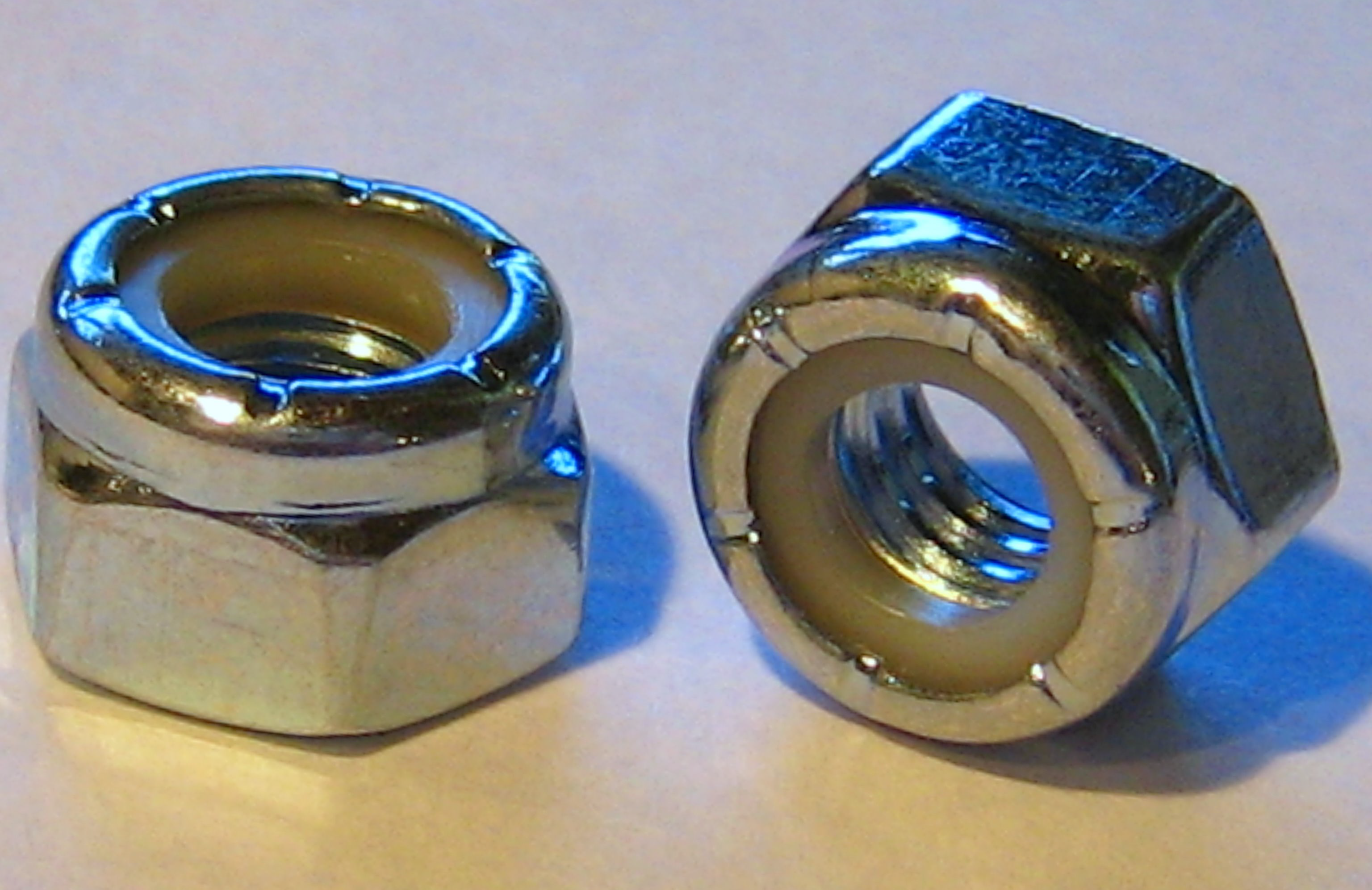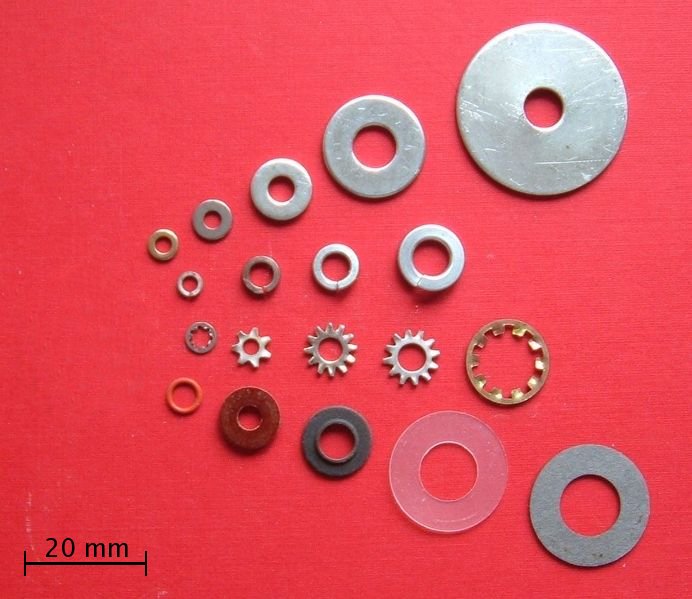|
Jam Nut
A jam nut is a low profile type of nut, typically half as tall as a standard nut. It is commonly used as a type of locknut, where it is "jammed" up against a standard nut to lock the two in place. It is also used in situations where a standard nut would not fit. The term "jam nut" can also refer to any nut that is used in the same function (even a standard nut used for the jamming purpose). Jam nuts, other types of locknuts, lock washers, and thread-locking fluid are ways to prevent vibration from loosening a bolted joint. Use of two nuts to prevent self-loosening In normal use, a nut-and-bolt joint holds together because the bolt is under a constant tensile stress called the ''preload''. The preload pulls the nut threads against the bolt threads, and the nut face against the bearing surface, with a constant force, so that the nut cannot rotate without overcoming the friction between these surfaces. If the joint is subjected to vibration, however, the preload increases and decre ... [...More Info...] [...Related Items...] OR: [Wikipedia] [Google] [Baidu] |
Counter Nut
Counter may refer to: Mathematics and computing * Counter machine, a subclass of register machines * Counter (digital), an electronic device, mechanical device, or computer program for counting * Loop counter, the variable that controls the iterations of a loop * Jeton, a reckoning counter used on reckoning boards for calculations * Mechanical counter, a digital counter using mechanical components * Tally counter, a mechanical counting device * Web counter, a counter that counts the number of visits to a web page * Project COUNTER, a standard for reporting usage statistics of electronic resources Games and sport * Counter (board wargames), a playing piece used in board wargames * Counter run, an offensive play in American football * Counter turn, an element in figure skating * Counter (collectible card games), a small item used to represent certain objects or conditions in a collectible card game * Jones Counter, measures distance bicycles travel Linguistics and typography * Count ... [...More Info...] [...Related Items...] OR: [Wikipedia] [Google] [Baidu] |
Nut (hardware)
A nut is a type of fastener with a screw thread, threaded hole. Nuts are almost always used in conjunction with a mating bolt (fastener), bolt to fasten multiple parts together. The two partners are kept together by a combination of their threads' friction (with slight deformation (engineering)#Elastic deformation, elastic deformation), a slight Tension (physics), stretching of the bolt, and compression (physics), compression of the parts to be held together. In applications where vibration or rotation may work a nut loose, various locking mechanisms may be employed: lock washers, jam nuts, eccentric double nuts, specialist adhesive thread-locking fluid such as Loctite, safety pins (split pins) or lockwire in conjunction with castellated nuts, nylon inserts (nyloc nut), or slightly oval-shaped threads. Square nuts, as well as bolt heads, were the first shape made and used to be the most common largely because they were much easier to manufacture, especially by hand. While rare to ... [...More Info...] [...Related Items...] OR: [Wikipedia] [Google] [Baidu] |
Locknut
A locknut, also known as a lock nut, locking nut, self-locking nut, prevailing torque nut,. stiff nut or elastic stop nut, is a nut that resists loosening under vibrations and torque. Prevailing torque nuts have some portion of the nut that deforms elastically to provide a locking action. Free-spinning locknuts exist which carry the advantage of not requiring extra torque until seated. Types There are various kinds of specialised lock nuts, including: * Castellated nut * Distorted thread locknut ** Centerlock nut **Elliptical offset locknut ** Toplock nut **Philidas nut * Interfering thread nut ** Tapered thread nut * Jam nut * Jet nut (K-nut). * Keps nut (K-nut or washer nut) with a free-spinning washer. In the locknut form, this is a star-type lock washer. * Plate nut * Polymer insert nut (Nyloc nut) * Security locknut All steel reusable nut for high vibration and harsh environments. * Serrated face nut * Serrated flange nut * Speed nut (sheet metal nut or Tinnerman nu ... [...More Info...] [...Related Items...] OR: [Wikipedia] [Google] [Baidu] |
Washer (hardware)
A washer is a thin plate (typically disk-shaped, but sometimes square) with a hole (typically in the middle) that is normally used to distribute the load of a threaded fastener, such as a bolt or nut. Other uses are as a spacer, spring (Belleville washer, wave washer), wear pad, preload indicating device, locking device, and to reduce vibration ( rubber washer). Washers are usually metal or plastic. High-quality bolted joints require hardened steel washers to prevent the loss of pre-load due to brinelling after the torque is applied. Washers are also important for preventing galvanic corrosion, particularly by insulating steel screws from aluminium surfaces. They may also be used in rotating applications, as a bearing. A ''thrust washer'' is used when a rolling element bearing is not needed either from a cost-performance perspective or due to space restraints. Coatings can be used to reduce wear and friction, either by hardening the surface or by providing a solid lubricant (i.e ... [...More Info...] [...Related Items...] OR: [Wikipedia] [Google] [Baidu] |
Thread-locking Fluid
Thread-locking fluid or threadlocker is a single-component adhesive, applied to the threads of fasteners such as screws and bolts to prevent loosening, leakage, and corrosion. Most thread-locking formulas are methacrylate-based and rely on the electrochemical activity of a metal substrate to cause polymerization of the fluid. Thread-locking fluid is thixotropic, which allows it to flow well over time, yet still resist shocks and vibrations. It can be permanent or removable; in the latter case, it can be removed with heat, for example. Typically, brands are color-coded to indicate strength and whether they can be removed easily or if they require heat for removal. History Thread-locking fluid was developed by American professor Vernon K. Krieble in 1953. His company, American Sealants, founded the Loctite brand. An early version of the compound was patented in 1960. Properties Typically, thread-locking fluids are methacrylate-based, and cure anaerobically. Thread-lockin ... [...More Info...] [...Related Items...] OR: [Wikipedia] [Google] [Baidu] |
Bolted Joint
A bolted joint is one of the most common elements in construction and machine design. It consists of a male threaded fastener (e. g., a bolt) that captures and joins other parts, secured with a matching female screw thread. There are two main types of bolted joint designs: tension joints and shear joints. Joint types In a tension joint, the bolt and clamped components of the joint are designed to transfer an applied tension load through the joint by way of the clamped components by the design of a proper balance of joint and bolt stiffness. The joint should be designed such that the clamp load is never overcome by the external tension forces acting to separate the joint. If the external tension forces overcome the clamp load (bolt preload) the clamped joint components will separate, allowing relative motion of the components. The second type of bolted joint transfers the applied load in shear of the bolt shank and relies on the shear strength of the bolt. Tension loads on such ... [...More Info...] [...Related Items...] OR: [Wikipedia] [Google] [Baidu] |
Tensile Stress
In continuum mechanics, stress is a physical quantity. It is a quantity that describes the magnitude of forces that cause deformation. Stress is defined as ''force per unit area''. When an object is pulled apart by a force it will cause elongation which is also known as deformation, like the stretching of an elastic band, it is called tensile stress. But, when the forces result in the compression of an object, it is called compressive stress. It results when forces like tension or compression act on a body. The greater this force and the smaller the cross-sectional area of the body on which it acts, the greater the stress. Therefore, stress is measured in newton per square meter (N/m2) or pascal (Pa). Stress expresses the internal forces that neighbouring particles of a continuous material exert on each other, while strain is the measure of the deformation of the material. For example, when a solid vertical bar is supporting an overhead weight, each particle in the bar pushes o ... [...More Info...] [...Related Items...] OR: [Wikipedia] [Google] [Baidu] |
Force
In physics, a force is an influence that can change the motion of an object. A force can cause an object with mass to change its velocity (e.g. moving from a state of rest), i.e., to accelerate. Force can also be described intuitively as a push or a pull. A force has both magnitude and direction, making it a vector quantity. It is measured in the SI unit of newton (N). Force is represented by the symbol (formerly ). The original form of Newton's second law states that the net force acting upon an object is equal to the rate at which its momentum changes with time. If the mass of the object is constant, this law implies that the acceleration of an object is directly proportional to the net force acting on the object, is in the direction of the net force, and is inversely proportional to the mass of the object. Concepts related to force include: thrust, which increases the velocity of an object; drag, which decreases the velocity of an object; and torque, which produce ... [...More Info...] [...Related Items...] OR: [Wikipedia] [Google] [Baidu] |
Friction
Friction is the force resisting the relative motion of solid surfaces, fluid layers, and material elements sliding against each other. There are several types of friction: *Dry friction is a force that opposes the relative lateral motion of two solid surfaces in contact. Dry friction is subdivided into ''static friction'' ("stiction") between non-moving surfaces, and ''kinetic friction'' between moving surfaces. With the exception of atomic or molecular friction, dry friction generally arises from the interaction of surface features, known as asperities (see Figure 1). *Fluid friction describes the friction between layers of a viscous fluid that are moving relative to each other. *Lubricated friction is a case of fluid friction where a lubricant fluid separates two solid surfaces. *Skin friction is a component of drag, the force resisting the motion of a fluid across the surface of a body. *Internal friction is the force resisting motion between the elements making up a so ... [...More Info...] [...Related Items...] OR: [Wikipedia] [Google] [Baidu] |
Vibration
Vibration is a mechanical phenomenon whereby oscillations occur about an equilibrium point. The word comes from Latin ''vibrationem'' ("shaking, brandishing"). The oscillations may be periodic function, periodic, such as the motion of a pendulum—or random, such as the movement of a tire on a gravel road. Vibration can be desirable: for example, the motion of a tuning fork, the Reed (music), reed in a woodwind instrument or harmonica, a mobile phone, or the cone of a loudspeaker. In many cases, however, vibration is undesirable, wasting energy and creating unwanted sound. For example, the vibrational motions of engines, electric motors, or any Machine, mechanical device in operation are typically unwanted. Such vibrations could be caused by Engine balance, imbalances in the rotating parts, uneven friction, or the meshing of gear teeth. Careful designs usually minimize unwanted vibrations. The studies of sound and vibration are closely related. Sound, or pressure waves, are ge ... [...More Info...] [...Related Items...] OR: [Wikipedia] [Google] [Baidu] |
Locking Nut
A locknut, also known as a lock nut, locking nut, self-locking nut, prevailing torque nut,. stiff nut or elastic stop nut, is a nut that resists loosening under vibrations and torque. Prevailing torque nuts have some portion of the nut that deforms elastically to provide a locking action. Free-spinning locknuts exist which carry the advantage of not requiring extra torque until seated. Types There are various kinds of specialised lock nuts, including: * Castellated nut * Distorted thread locknut **Centerlock nut **Elliptical offset locknut **Toplock nut **Philidas nut * Interfering thread nut **Tapered thread nut * Jam nut * Jet nut (K-nut). * Keps nut (K-nut or washer nut) with a free-spinning washer. In the locknut form, this is a star-type lock washer. * Plate nut * Polymer insert nut (Nyloc nut) * Security locknut All steel reusable nut for high vibration and harsh environments. * Serrated face nut * Serrated flange nut * Speed nut (sheet metal nut or Tinnerman nut) * ... [...More Info...] [...Related Items...] OR: [Wikipedia] [Google] [Baidu] |
Torque
In physics and mechanics, torque is the rotational equivalent of linear force. It is also referred to as the moment of force (also abbreviated to moment). It represents the capability of a force to produce change in the rotational motion of the body. The concept originated with the studies by Archimedes of the usage of levers, which is reflected in his famous quote: "''Give me a lever and a place to stand and I will move the Earth''". Just as a linear force is a push or a pull, a torque can be thought of as a twist to an object around a specific axis. Torque is defined as the product of the magnitude of the perpendicular component of the force and the distance of the line of action of a force from the point around which it is being determined. The law of conservation of energy can also be used to understand torque. The symbol for torque is typically \boldsymbol\tau, the lowercase Greek letter ''tau''. When being referred to as moment of force, it is commonly denoted by . In ... [...More Info...] [...Related Items...] OR: [Wikipedia] [Google] [Baidu] |





